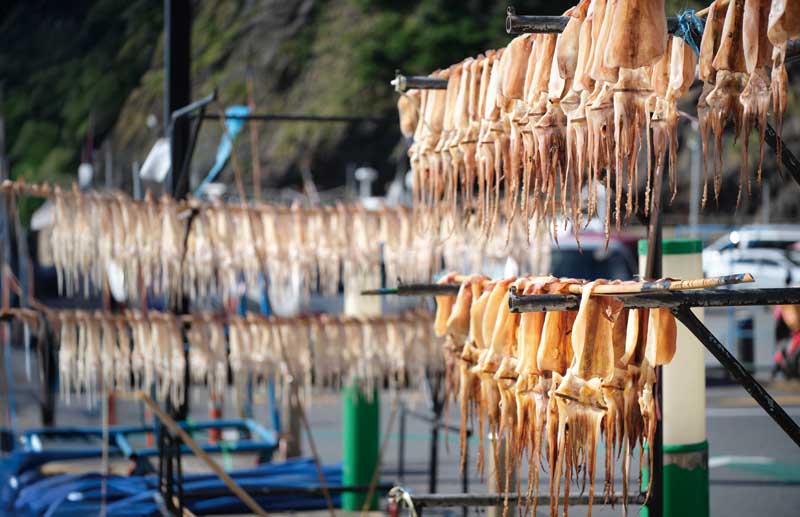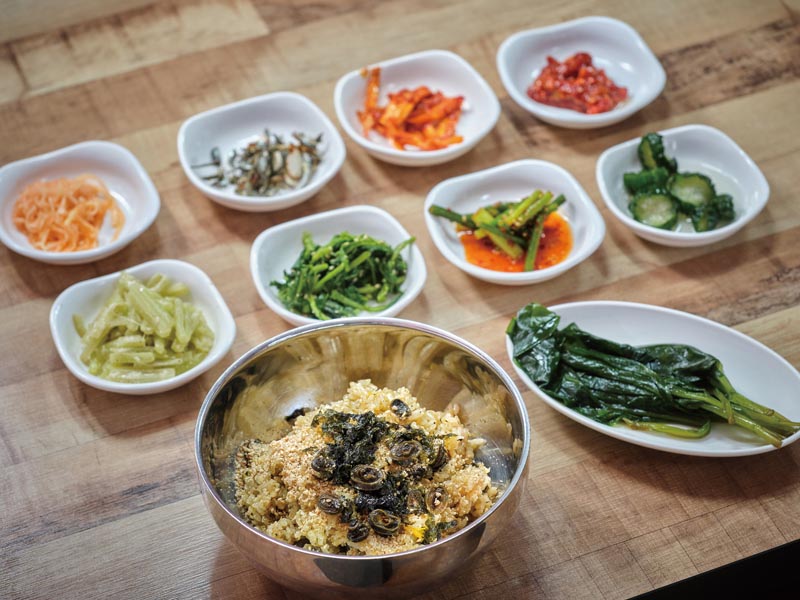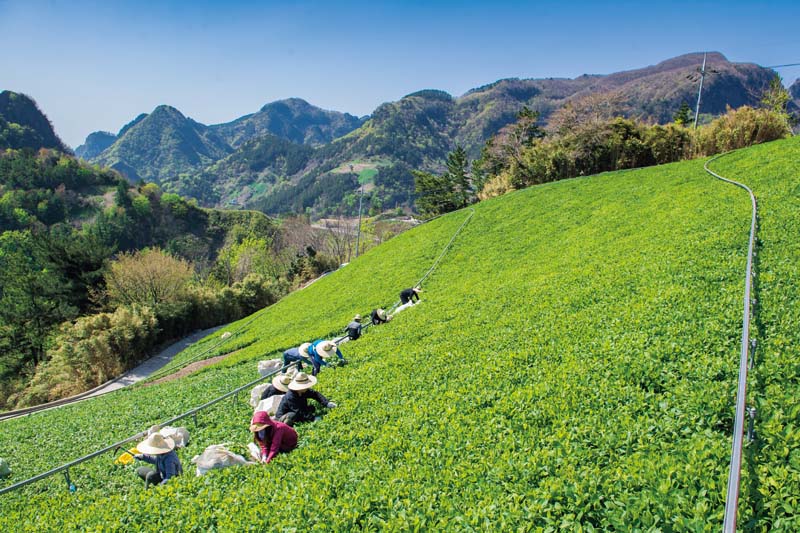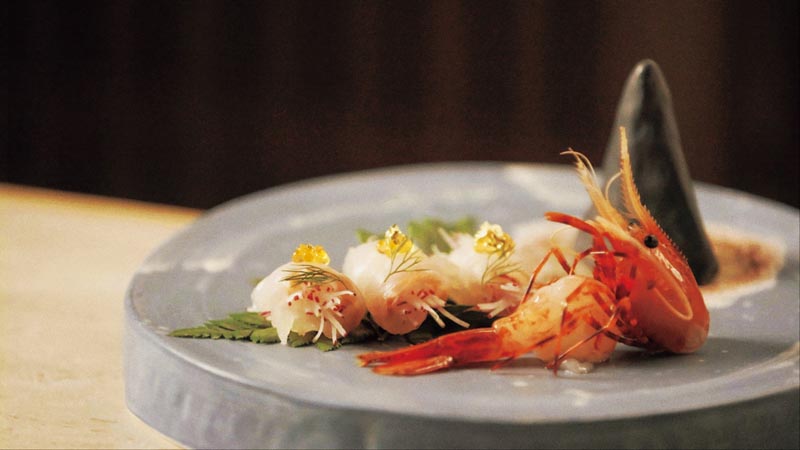Among Korea’s exceptionally large number of islands, Ulleungdo stands out for its prominent gastronomic culture. With an abundance of seafood, native Korean beef, and various wild plants that are difficult to find on the mainland, this lonely volcanic island in the East Sea is a special culinary destination that beckons travelers with mouth-watering delicacies.

Fishers on Ulleungdo forgo hot air or machinery, instead drying squid the traditional way: in sea breezes, resulting in better flavor and aroma. Another practice unique to the island involves puncturing the squid’s “ear” and hanging them from poles to dry.
Islands are often symbols of isolation and disconnection. However, these very qualities have allowed distinctive island cuisines to develop without the influence of external elements.
This is especially true for Ulleungdo. The signature dish here is bibimbap — an iconic Korean creation of rice and assorted vegetables, mixed together with gochujang (red pepper paste) and topped with a fried egg. It’s now popular around the world, with even a Hollywood actor having posted a bibimbap recipe on social media. Given its widespread familiarity, one might wonder what distinguishes Ulleungdo’s version. And yet, singular ingredients make the island’s interpretation of bibimbap distinctly different from mainland counterparts.
BIBIMBAP WITH A DIFFERENCE
Ulleungdo’s most celebrated version of the dish is barnacle bibimbap; the tiny creatures that cling tenaciously to seaside rocks are the star ingredient. A lavish mound of these morsels, smaller than abalone and with a distinct marine aroma, is served atop a portion of cooked rice. A sprinkling of ground sesame seeds and a drizzle of sesame oil are added to create a symphony of textures and flavors. Found at most restaurants across the island’s ports, this dish has become a hallmark of Ulleungdo’s gastronomic identity. Barnacles are also found in other dishes such as kalguksu (knife-cut noodles) and rice porridge.

Barnacle bibimbap, a local specialty, is a labor-intensive dish. Female divers and fishermen harvest barnacles from coastal rocks and prepare them by hand, a labor of love rewarded with a chewy, crunchy texture and wonderful flavor.
Another take on bibimbap that highlights the flavor of the sea features mussels gathered from the pristine waters surrounding Ulleungdo. Christened seop to distinguish them from farmed mussels (called honghap), these shellfish have a chewy texture and characteristic briny flavor. The more they are chewed, the more their refreshing sweetness spreads, offering an unforgettable dining experience.
Of course, Ulleungdo’s notable bibimbap ingredients go beyond seafood. Many restaurants across the island offer vegetable-based set meals centered on the dish, distinguished from mainland versions by the inclusion of unique local namul (wild greens). The most prolific namul-producing area is the Nari Basin, Ulleungdo’s only area of flatland. The level terrain here contrasts with the surrounding peaks, and allowed several villages to form. Many of them now have restaurants serving bibimbap made with a variety of namul grown nearby.
NATIVE WILD GREENS
While many namul are now cultivated, the simplest definition of the term is “edible plants gathered from the wild.” They serve a unique purpose in food, acting neither as vegetables nor as herbs that add aroma. Koreans discovered their gastronomic value early on; through millennia of Korean history, these greens have been added to soups or prepared as side dishes, either stir-fried or blanched and seasoned. Thanks to the country’s temperate climate and four distinct seasons, namul taste different depending on the time of year. For example, sun-dried namul soaked and cooked during winter offer flavors distinct from those enjoyed in spring.
As Korean food gains global popularity, these greens are increasingly considered delicacies in other countries, or incorporated into menus at fine dining restaurants in major cities around the world. Once eaten simply because they were inexpensive and easy to obtain, namul — with their diverse flavors that sometimes even resemble meat — have gained the status of a premium health food.

Rich in vitamins and various nutrients, bujigaengi is an Ulleungdo specialty popular for its taste and aroma. Cultivated on approximately 40 hectares, it generates the highest income among the island’s field crops.
© Ulleung-gun Office
Ulleungdo’s volcanic terrain is home to a variety of rare namul that are difficult to find elsewhere. One prominent example is myeongi-namul, a type of mountain garlic. The name reflects history: early settlers facing severe food shortages during harsh winters discovered this hardy plant while ploughing through snow in search of sustenance. They named it “myeongi” in acknowledgment of its role in prolonging their lives, or “myeong.” Traditionally consumed pickled or as ssam, wrapped around rice or meat, myeongi has grown popular on the mainland as a health food. Increased demand has led farmers to cultivate the plant, now a significant source of income on the island. Notably, pickled myeongi, with its sweet and sour flavor, pairs perfectly with fatty grilled pork belly.
Another celebrated namul found exclusively on Ulleungdo is seommal nari (Hanson’s lily). Globally rare, it was listed on the Ark of Taste in 2013, along with the island’s Chikso cattle. The Ark of Taste is a project run by the Slow Food Foundation to catalog local endangered foods that should be protected. Today, island residents are actively restoring traditional recipes that include seommal nari, and conserving its seeds.
Deodeok, or bellflower root, a native Korean plant cultivated nationwide, is valued for its high fiber content and low calories. It is popularly prepared grilled: the roots are cleaned, pounded flat, and brushed with a sweet and spicy seasoning before being cooked. Fresh raw deodeok is seasoned to make deodeok muchim, a crisp and fragrant side dish. The roots can also be pickled or cooked with rice. Unique to Ulleungdo is deodeok juice, made with high-quality, island-grown roots, and commonly sold at the entrance to hiking trails. Other notable namul found on the island include bujigaengi (Amur wallflower) and sam-namul (Kamchatka goatsbeard).
EXPANDING THE PALATE
Restaurants near Dodong Harbor typically specialize in beef, often serving yakso (“medicinal cattle”), a local variety of Hanwoo, a native Korean cattle breed that has distinctive black stripes and a yellow-brown body. The name reflects the belief that these cattle, fed on Ulleungdo’s various wild plants and pristine water, possess medicinal properties.
Hanwoo are believed to have been raised on the Korean peninsula since 2000 BCE. Historically, this indigenous breed of pure native lineage was an invaluable farm animal that provided primary labor for agriculture, making the cows a rural family’s most prized possessions. Various native breeds of cattle have also existed through the centuries, named for their coat color: Hwangso (yellow-brown), Chikso (brindled), and Heugu (black). Although they faced near extinction during the Japanese colonial period (1910–1945), government and local authorities have actively worked to restore them in recent decades. In 2006, the Ministry of Culture, Sports and Tourism recognized Hanwoo in particular as one of the one hundred symbols of Korean culture. The meat’s tenderness and rich, savory flavor have earned praise from world-renowned chefs visiting Korea.

Jeodong Port has been famous for its squid fishing vessels since ancient times. The lights of these boats glowing on the dark night sea create one of Ulleungdo's most beautiful and iconic sights.
Another Ulleungdo specialty that must be mentioned is squid. Sold in bundles, dried squid has long been a popular souvenir for tourists. Dried in the island’s clean sea breezes and warm sunlight, it has a rich, savory flavor that grows stronger as you chew. The thick, meaty texture enhances its appeal. Squid is caught at night and immediately processed and sold the next morning, so it’s always exceptionally fresh.
Ulleungdo cuisine naturally features a variety of squid-based dishes. One of these is squid intestine soup, a nourishing dish that also incorporates vegetables. This soup can only be made with the freshest squid because the digestive tract spoils very quickly after the animal dies. Meanwhile, a popular summer dish is spicy cold squid soup, consisting of thin squid slices in cold water mixed with rice. Other standout dishes include squid bulgogi and squid sundae — whole squid filled with seasoned stuffing and then steamed.
The cuisine of island environments often evolves or is adapted to please mainland palates as visitor traffic increases. However, Ulleungdo’s signature dishes have retained their distinctive character while broadening travelers’ culinary horizons.

This dish, featuring Dokdo shrimp and other seasonal island ingredients, can be tasted at the KOSMOS ULLEUNGDO restaurant, which presents fine dining based on Ulleungdo's unique ingredients.
© KOSMOS ULLEUNGDO